Study on Key Parameters for Jet Impacting Pulverized Coal Deposited in Coal-Bed Methane Wells
Abstract
:1. Introduction
2. Theoretical Model
3. Modelling and Meshing
3.1. Parameters of the Model
3.2. Verification of This Case
4. Discussion
- (a)
- The depth and width of the pit grow rapidly during the first stage. At this stage, the jet has left-right symmetry around the jet axis.
- (b)
- The second stage is the stabilization period. The scouring pit stabilizes at a well-defined depth and width. At this stage, the scouring pit may also continue to slightly grow in size.
- (c)
- The jet exhibits oscillations during the third stage. The jet becomes asymmetrical and starts to “oscillate” from left to right, where the inner surface of the casing (system boundary) is the stationary point of the oscillation. The jet continues to scour the left and right sides of the scour pit, which continues to expand in width but not in depth.
- (d)
- The fourth stage is the dynamic stabilisation stage. At this stage, the jet continues to oscillate around the jet axis, albeit with a well-defined amplitude, and the scour range is also well-defined. Therefore, the depth and width of the pit do not change significantly, and the scouring pit reaches a state of dynamic equilibrium.
4.1. Target Distance
4.2. Nozzle Diameter
4.3. Nozzle Outflow Velocity
5. Conclusions
- (1)
- The deposition of pulverized coal by jet impacting can be categorised into four phases: rapid growth, stabilisation, jet oscillation and dynamic stabilisation. It takes about 6.8 s from the start of the jet to the dynamic stabilization stage, which is a guiding role for the residence time of the pulverized coal impacting unit during CBM well impacting. At the same time, there is a decreasing trend of impact depth variation after 6.8 s. Therefore, the residence time of the jet device should be no more than 6.8 s when impacting the pulverized coal at the bottom of the well, at which time the jet flushing device should continue to move downward slowly, in order to ensure the efficiency of impacting pulverized coal.
- (2)
- The onset time for the jet oscillation stage decreases with increasing target distance and increases with the diameter and outflow velocity of the nozzle. There is a constant energy exchange between the jet and the surrounding fluid and solids. The energy loss on both sides of the jet appears to be unequal. When the energy difference between the two sides of the jet develops to more than a certain amount, which varies under different conditions, the phenomenon of jet oscillation occurs.
- (3)
- In the process of jet impacting deposited pulverized coal, the impact pit can reach the maximum depth at 3 s, while it takes 7 s to reach the maximum width. Considering the best flushing effect, it is recommended that the single point hovering time of the equipment should not be less than 7 s during the operation of deposited pulverized coal flushing. If the hovering time is less than 7 s, the jet will not be able to effectively drive the movement of the pulverized coal deposited near the inner wall of the casing. This will significantly reduce the pulverized coal cleaning efficiency.
- (4)
- The depth and width of the pit decrease with increasing target distance. The depth and width of the pit increase with both the diameter and outflow velocity of the nozzle. Therefore, for the parameter design of the jet device, larger nozzles should be selected or the pressure of the power fluid for impacting pulverized coal should be higher while considering the balance between operating costs and efficiency of deposited pulverized coal flushing.
Author Contributions
Funding
Institutional Review Board Statement
Informed Consent Statement
Data Availability Statement
Conflicts of Interest
References
- Lan, W.; Wang, H.; Yang, S.; Zheng, C.; Liu, Y.; Chen, S. Study on the migration of pulverized coal in CBM wellbore. J. Pet. Sci. Eng. 2017, 156, 740–747. [Google Scholar] [CrossRef]
- Liu, B.; Du, J.Y.; Qi, Y.G.; Zhang, F.N.; Yu, Y.Q.; Zhao, H.H. A new coal particles cleanout technology in coalbed methane wells in China. J. Pet. Sci. Eng. 2015, 127, 445–451. [Google Scholar] [CrossRef]
- Liu, X.; Liu, C.; Wu, J. A Modern Approach to Analyzing the Flowing Pressures of a Two-Phase CBM and Water Column in Producing Wellbores. Geofluids 2019, 2019, 1–9. [Google Scholar] [CrossRef]
- Liu, X. Development of Prime Mover Loading on the Sucker Rod Lift During Coalbed Methane Production. Iran. J. Sci. Technol. Trans. Mech. Eng. 2020, 44, 263–272. [Google Scholar] [CrossRef]
- Ma, F.; Liu, Q.; Wang, L.; Liu, D.; Chen, Z.; Wen, F. Initiation of coal powders deposits in coal seam cracks at the stage of single-phase water flow. J. China Coal Soc. 2016, 41, 917–920. [Google Scholar] [CrossRef]
- Wei, Y.; Cao, D.; Yuan, Y.; Zhu, X.; Zhang, X.; Yao, Z.; Zhou, J. Characteristics of pulverized coal during coalbed methane drainage in Hancheng block, Shaanxi Province, China. Energy Explor. Exploit. 2013, 31, 745–757. [Google Scholar] [CrossRef]
- Qi, Y.; Zhang, F.; Liu, B.; Meng, S.; Zhu, H.; Du, J.; Mo, R. Analysis of characteristics of coal powders movement in gas production channels of coalbed methane wells. J. China Coal Soc. 2013, 38, 1627–1633. [Google Scholar] [CrossRef]
- Xiong, X.Y.; Cao, D.Y.; Jie, M.X.; Bai, Y.; Zhu, X.S.; Che, Y.Q.; Zhang, A.X. Research on the Controlling Factors and Grate Prediction of the Output of Pulverized Coal in Hancheng Block, Eastern Ordos Gas Field. Adv. Mater. Res. 2013, 734–737, 1460–1463. [Google Scholar] [CrossRef]
- Gong, S.; He, F.; Liu, K.; Long, X. Parameter Characteristics of Using the High-speed Air Jet to Impact Granular Material Layer. J. Mech. Eng. 2015, 51, 142–147. [Google Scholar] [CrossRef]
- Xia, B.; Ni, F.; Gu, L. Numerical simulation of the effect of submerged depth on the jet-scouring of sediment. Mech. Des. Manuf. Eng. 2020, 49, 72–75. [Google Scholar]
- Huai, W.; Wang, Z.; Qian, Z.; Han, Y. Numerical simulation of sandy bed erosion by 2D vertical jet. Sci. China Technol. Sci. 2011, 54, 3265–3274. [Google Scholar] [CrossRef]
- Zhao, M.; Cheng, L. Numerical modeling of local scour below a piggyback pipeline in currents. J. Hydraul. Eng. 2008, 134, 1452–1463. [Google Scholar] [CrossRef]
- Jin, C.; Chen, C.; Pan, D.; Zhu, Y.; Li, X.; Zhong, X.; Zhang, H.; Zhang, Y. Influence of key parameters of submerged water jets on the erosion volume of natural gas hydrate sediments. Explor. Eng. Soil Drill. Tunn. 2019, 46, 1–7. [Google Scholar] [CrossRef]
- Cui, J.; Li, P.; Ma, D.; Li, Z.; Zhang, K.; Meng, F. Experiment study on migration law of pulverized coal in borehole of coalbed methane horizontal well. Coal Sci. Technol. 2016, 44, 74–78. [Google Scholar] [CrossRef]
- Zhang, F.; Li, M.; Qi, Y.; Zhu, H.; Meng, S. Analysis of pulverized coal migration during CBM production. J. China Univ. Pet. Ed. Natrual Sci. 2015, 39, 86–92. [Google Scholar]
- Mo, R.; Zhang, F.; Qi, Y.; He, Y.; Zhang, G. Movement of Pulverized Coal in Sucker Rod Pump in Coalbed Methane Well. J. Southwest Pet. Univ. Sci. Technol. Ed. 2016, 38, 143–150. [Google Scholar] [CrossRef]
- Gad, M.S.; He, Z.; EL-Shafay, A.S.; EL-Seesy, A.I. Combustion characteristics of a diesel engine running with Mandarin essential oil -diesel mixtures and propanol additive under different exhaust gas recirculation: Experimental investigation and numerical simulation. Case Stud. Therm. Eng. 2021, 26, 101100. [Google Scholar] [CrossRef]
- Liu, S.; Hu, A.; Song, B.; Li, H. Coal powder concentration warning and control measure during CBM well drainage. J. China Coal Soc. 2012, 37, 86–90. [Google Scholar]
- Bai, T.; Chen, Z.; Aminossadati, S.M.; Pan, Z.; Liu, J.; Li, L. Characterization of coal fines generation: A micro-scale investigation. J. Nat. Gas Sci. Eng. 2015, 27, 862–875. [Google Scholar] [CrossRef] [Green Version]
- Bai, T.; Chen, Z.; Aminossadati, S.M.; Li, L.; Liu, J.; Lu, H. Dimensional analysis and prediction of coal fines generation under two-phase flow conditions. Fuel 2017, 194, 460–479. [Google Scholar] [CrossRef]
- Han, W.; Wang, Y.; Li, Y.; Ni, X.; Wu, X.; Yang, J.; Zhao, S. Coal Fines Migration, Deposition, and Output Simulation during Drainage Stage in Coalbed Methane Production. Energy Fuels 2021, 35, 4901–4913. [Google Scholar] [CrossRef]
- Guo, Z.; Hussain, F.; Cinar, Y. Physical and analytical modelling of permeability damage in bituminous coal caused by fines migration during water production. J. Nat. Gas Sci. Eng. 2016, 35, 331–346. [Google Scholar] [CrossRef]
- Guan, W.; He, Z.; Zhang, L.; EL-Seesy, A.I.; Wen, L.; Zhang, Q.; Yang, L. Effect of asymmetric structural characteristics of multi-hole marine diesel injectors on internal cavitation patterns and flow characteristics: A numerical study. Fuel 2021, 283, 119324. [Google Scholar] [CrossRef]
- Li, Y.; Han, W.; Wang, Y.; Meng, S.; Wu, X.; Wang, Z.; Ma, Z.; Liu, D.; Zhao, S. Progress of coal fines agglomeration and settlement mechanism based on high efficiency coalbed methane drainage. Coal Geol. Explor. 2021, 49, 1–12. [Google Scholar]
- Gidaspow, D. Multiphase Flow and Fluidization: Continuum and Kinetic Theory Descriptions; Academic Press: Boston, MA, USA, 1994; ISBN 978-0-12-282470-8. [Google Scholar]
- Asakura, K.; Asari, T.; Nakajima, I. Simulation of solid-liquid flows in a vertical pipe by a collision model. Powder Technol. 1997, 94, 201–206. [Google Scholar] [CrossRef]
- Jenkins, J.T.; Savage, S.B. A theory for the rapid flow of identical, smooth, nearly elastic, spherical-particles. J. Fluid Mech. 1983, 130, 187–202. [Google Scholar] [CrossRef]
- Fu, X.; Wang, G. Kinetic analysis of the constitutive relationship of particles in low-concentration solid-liquid two-phase flow. J. Tsinghua Univ. Nat. Sci. Ed. 2002, 42, 560–563. [Google Scholar] [CrossRef]


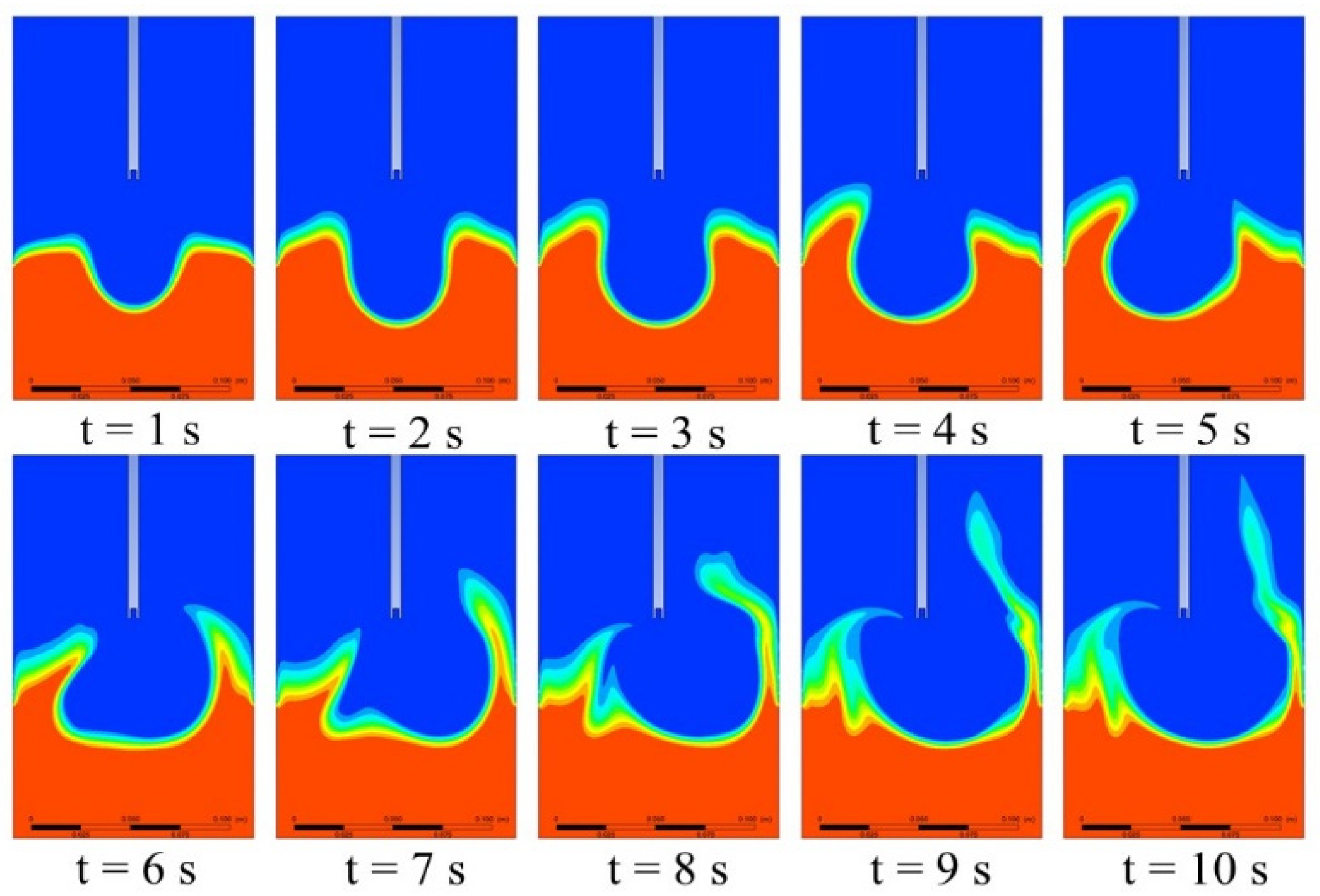
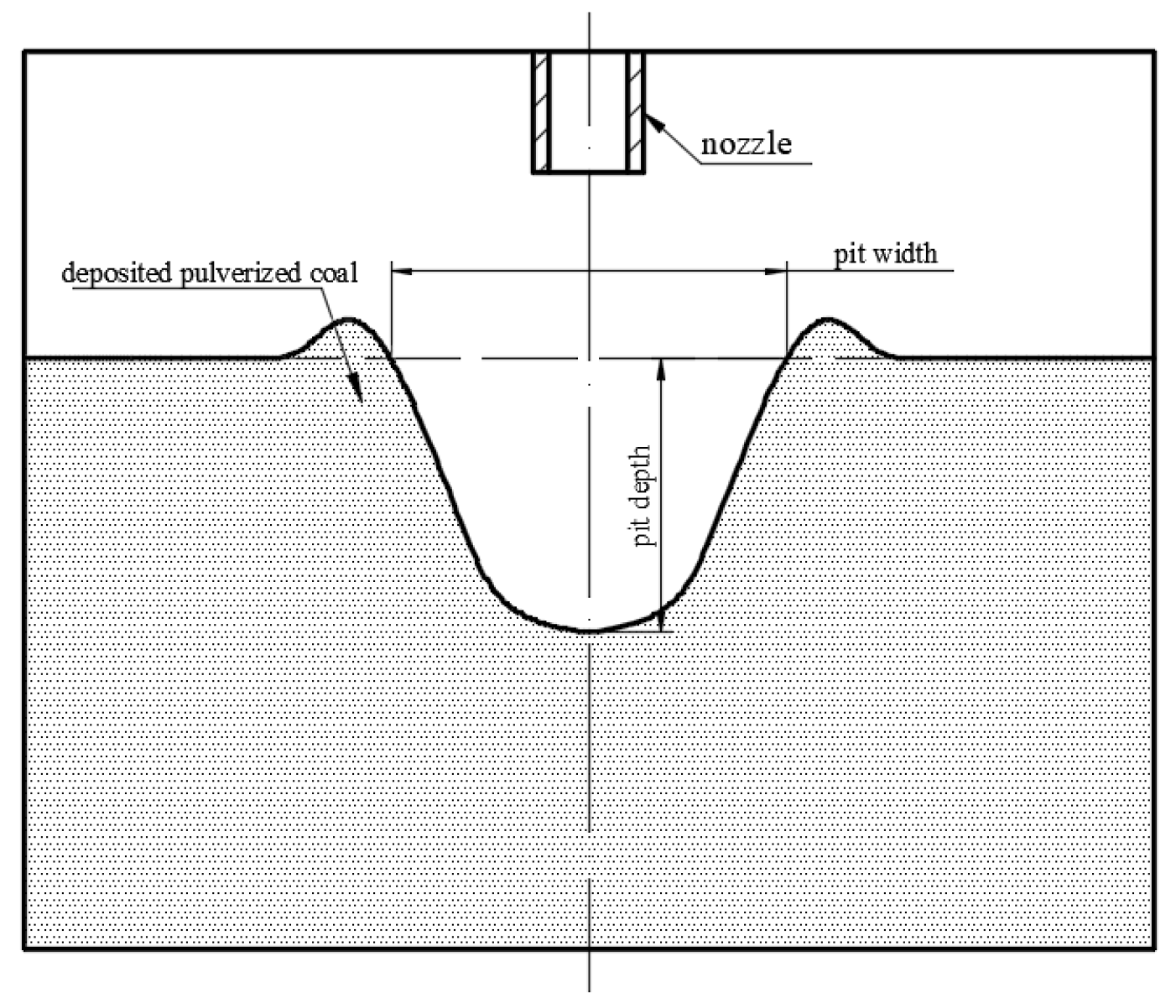
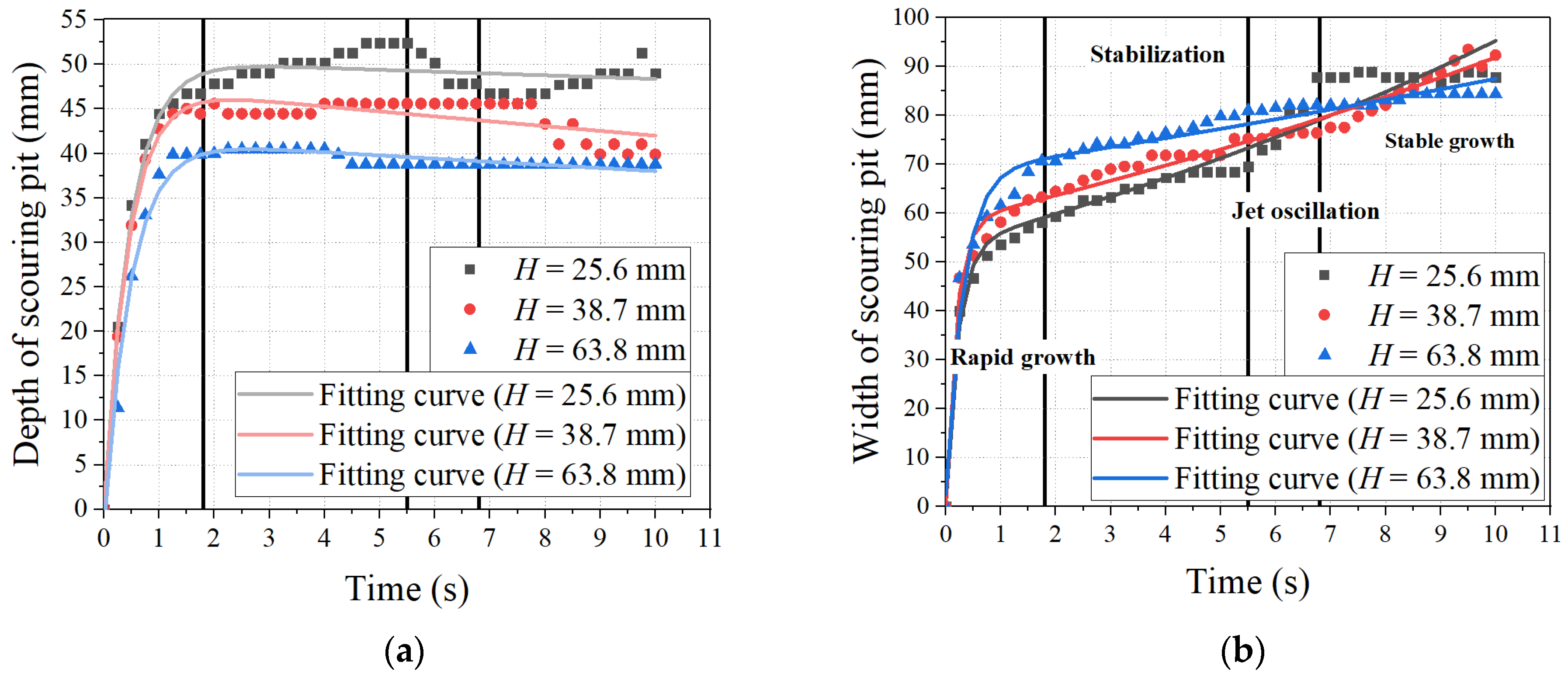
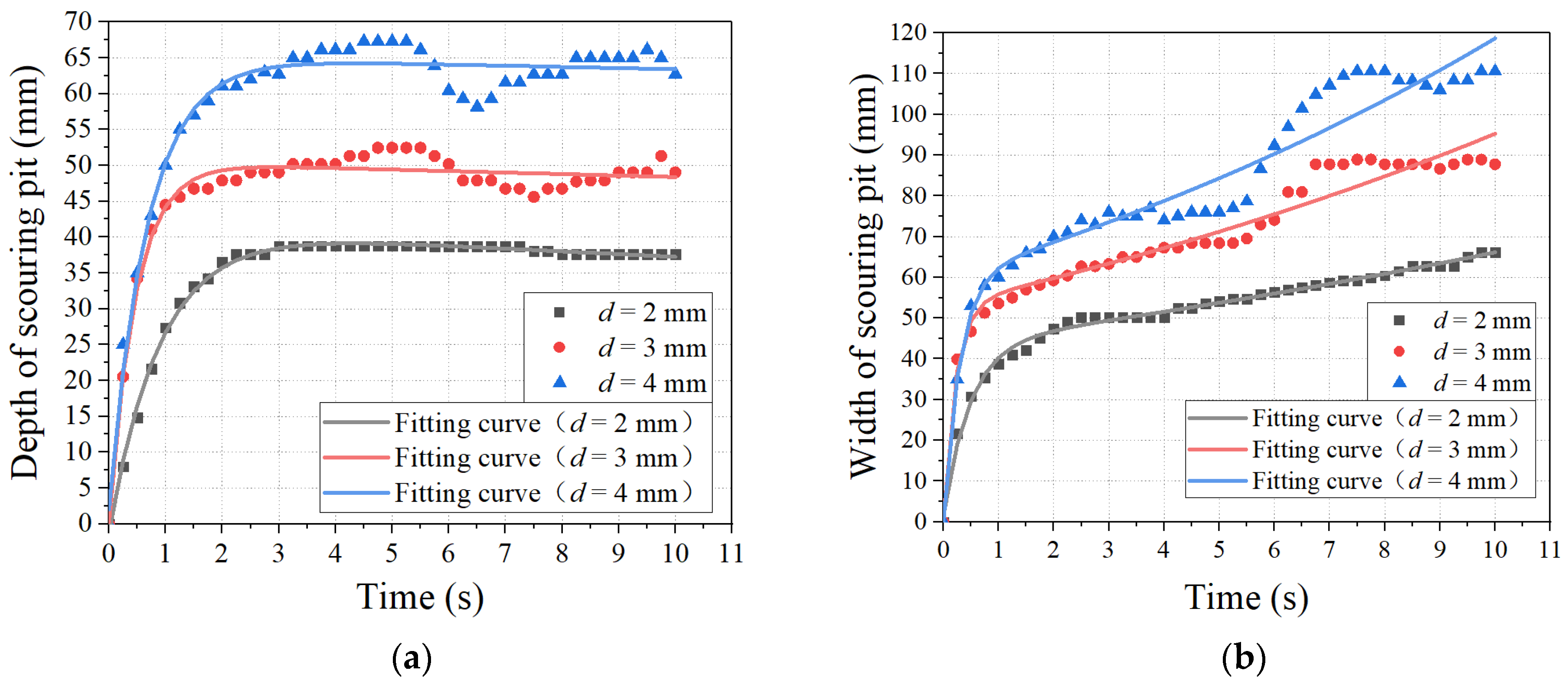
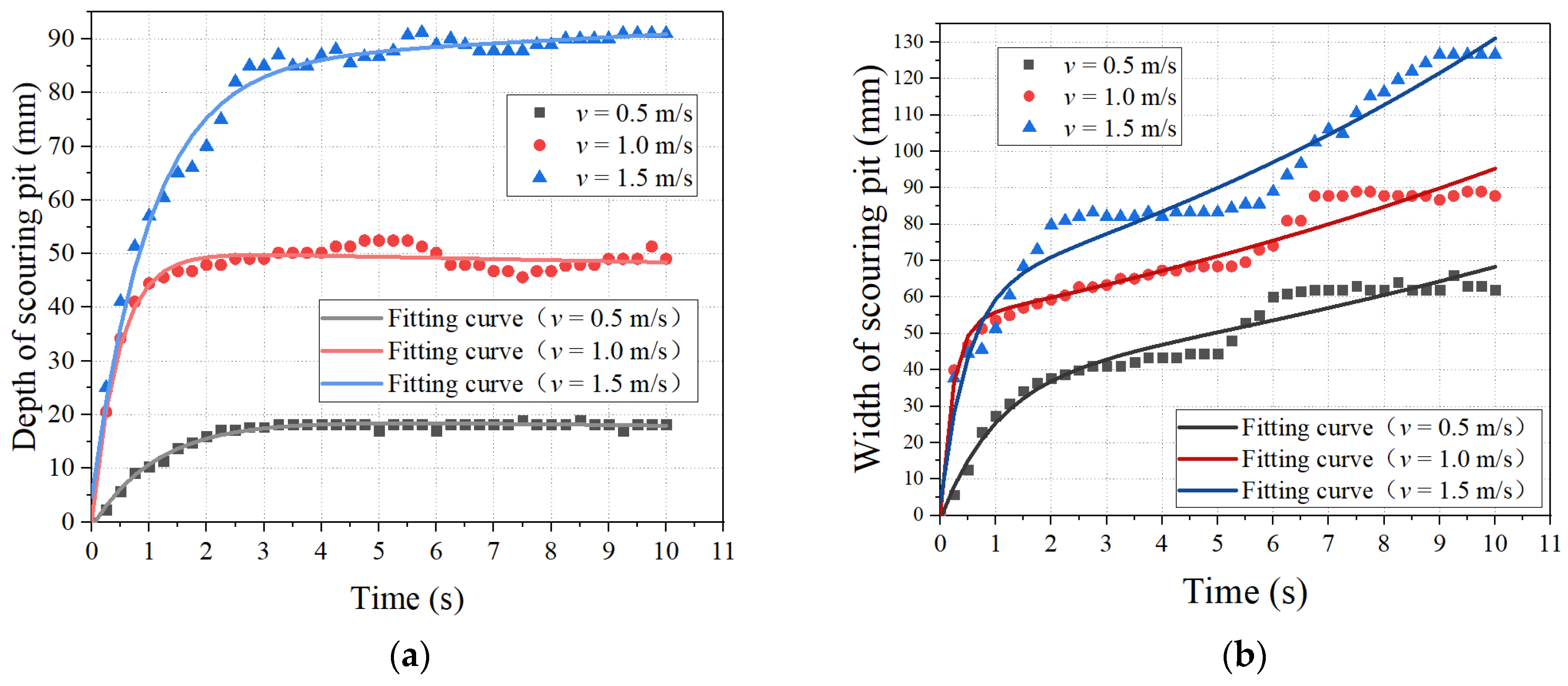
| No. | H (mm) | d (mm) | V (m/s) |
|---|---|---|---|
| 1 | 28.6 | 2 | 0.5 |
| 2 | 38.7 | 3 | 1.0 |
| 3 | 63.8 | 4 | 1.5 |
Publisher’s Note: MDPI stays neutral with regard to jurisdictional claims in published maps and institutional affiliations. |
© 2022 by the authors. Licensee MDPI, Basel, Switzerland. This article is an open access article distributed under the terms and conditions of the Creative Commons Attribution (CC BY) license (https://creativecommons.org/licenses/by/4.0/).
Share and Cite
Zhu, H.; Xue, L.; Zhang, F.; Qi, Y.; Zhao, J.; Feng, D. Study on Key Parameters for Jet Impacting Pulverized Coal Deposited in Coal-Bed Methane Wells. Coatings 2022, 12, 1454. https://doi.org/10.3390/coatings12101454
Zhu H, Xue L, Zhang F, Qi Y, Zhao J, Feng D. Study on Key Parameters for Jet Impacting Pulverized Coal Deposited in Coal-Bed Methane Wells. Coatings. 2022; 12(10):1454. https://doi.org/10.3390/coatings12101454
Chicago/Turabian StyleZhu, Hongying, Likun Xue, Fenna Zhang, Yaoguang Qi, Junwei Zhao, and Dehua Feng. 2022. "Study on Key Parameters for Jet Impacting Pulverized Coal Deposited in Coal-Bed Methane Wells" Coatings 12, no. 10: 1454. https://doi.org/10.3390/coatings12101454
APA StyleZhu, H., Xue, L., Zhang, F., Qi, Y., Zhao, J., & Feng, D. (2022). Study on Key Parameters for Jet Impacting Pulverized Coal Deposited in Coal-Bed Methane Wells. Coatings, 12(10), 1454. https://doi.org/10.3390/coatings12101454






